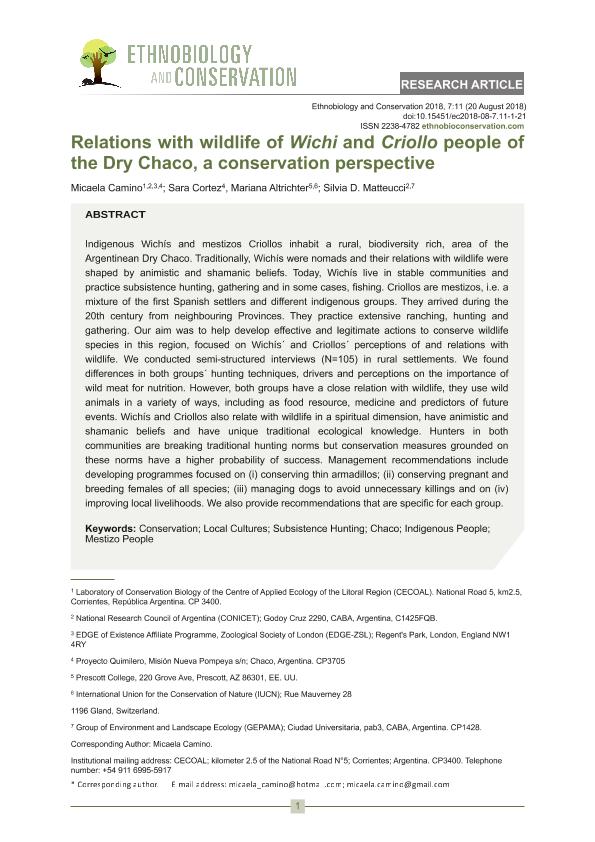Mostrar el registro sencillo del ítem
dc.contributor.author
Camino, Micaela

dc.contributor.author
de Sousa Mendes Parreira Cortez, Sara

dc.contributor.author
Altrichter, Mariana

dc.contributor.author
Matteucci, Silvia Diana

dc.date.available
2019-12-03T21:35:53Z
dc.date.issued
2018-08
dc.identifier.citation
Camino, Micaela; de Sousa Mendes Parreira Cortez, Sara; Altrichter, Mariana; Matteucci, Silvia Diana; Relations with wildlife of Wichi and Criollo people of the Dry Chaco, a conservation perspective; Universidade Federal Rural de Pernambuco; Ethnobiology and Conservation; 7; 8-2018; 1-21
dc.identifier.uri
http://hdl.handle.net/11336/91292
dc.description.abstract
Indigenous Wichís and mestizos Criollos inhabit a rural, biodiversity rich, area of the Argentinean Dry Chaco. Traditionally, Wichís were nomads and their relations with wildlife were shaped by animistic and shamanic beliefs. Today, Wichís live in stable communities and practice subsistence hunting, gathering and in some cases, fishing. Criollos are mestizos, i.e. a mixture of the first Spanish settlers and different indigenous groups. They arrived during the 20th century from neighbouring Provinces. They practice extensive ranching, hunting and gathering. Our aim was to help develop effective and legitimate actions to conserve wildlife species in this region, focused on Wichís' and Criollos' perceptions of and relations with wildlife. We conducted semistructured interviews (N=105) in rural settlements. We found differences in both groups' hunting techniques, drivers and perceptions on the importance of wild meat for nutrition. However, both groups have a close relation with wildlife, they use wild animals in a variety of ways, including as food resource, medicine and predictors of future events. Wichís and Criollos also relate with wildlife in a spiritual dimension, have animistic and shamanic beliefs and have unique traditional ecological knowledge. Hunters in both communities are breaking traditional hunting norms but conservation measures grounded on these norms have a higher probability of success. Management recommendations include developing programmes focused on (i) conserving thin armadillos; (ii) conserving pregnant and breeding females of all species; (iii) managing dogs to avoid unnecessary killings and on (iv) improving local livelihoods. We also provide recommendations that are specific for each group.
dc.format
application/pdf
dc.language.iso
eng
dc.publisher
Universidade Federal Rural de Pernambuco
dc.rights
info:eu-repo/semantics/openAccess
dc.rights.uri
https://creativecommons.org/licenses/by-nc-sa/2.5/ar/
dc.subject
CHACO
dc.subject
CONSERVATION
dc.subject
INDIGENOUS PEOPLE
dc.subject
LOCAL CULTURES
dc.subject
MESTIZO PEOPLE
dc.subject
SUBSISTENCE HUNTING
dc.subject.classification
Conservación de la Biodiversidad

dc.subject.classification
Ciencias Biológicas

dc.subject.classification
CIENCIAS NATURALES Y EXACTAS

dc.title
Relations with wildlife of Wichi and Criollo people of the Dry Chaco, a conservation perspective
dc.type
info:eu-repo/semantics/article
dc.type
info:ar-repo/semantics/artículo
dc.type
info:eu-repo/semantics/publishedVersion
dc.date.updated
2019-10-24T18:17:37Z
dc.identifier.eissn
2238-4782
dc.journal.volume
7
dc.journal.pagination
1-21
dc.journal.pais
Brasil

dc.journal.ciudad
Pernambuco
dc.description.fil
Fil: Camino, Micaela. Consejo Nacional de Investigaciones Científicas y Técnicas. Centro Científico Tecnológico Conicet - Nordeste. Centro de Ecología Aplicada del Litoral. Universidad Nacional del Nordeste. Centro de Ecología Aplicada del Litoral; Argentina. The Zoological Society of London; Reino Unido. Proyecto Quimilero; Argentina
dc.description.fil
Fil: de Sousa Mendes Parreira Cortez, Sara. Proyecto Quimilero; Argentina
dc.description.fil
Fil: Altrichter, Mariana. Prescott University; Estados Unidos. International Union for Conservation of Nature; Suiza
dc.description.fil
Fil: Matteucci, Silvia Diana. Consejo Nacional de Investigaciones Científicas y Técnicas; Argentina. Universidad de Buenos Aires. Facultad de Arquitectura y Urbanismo. Grupo de Ecología del Paisaje y Medio Ambiente; Argentina
dc.journal.title
Ethnobiology and Conservation
dc.relation.alternativeid
info:eu-repo/semantics/altIdentifier/url/http://ethnobioconservation.com/index.php/ebc/article/view/233
dc.relation.alternativeid
info:eu-repo/semantics/altIdentifier/doi/http://dx.doi.org/10.15451/ec2018-08-7.11-1-21
Archivos asociados
